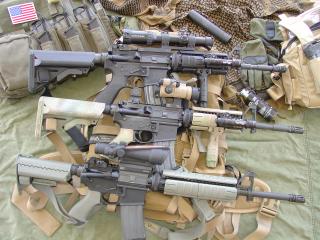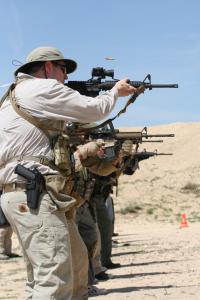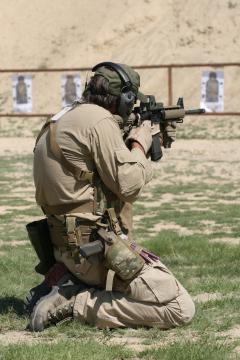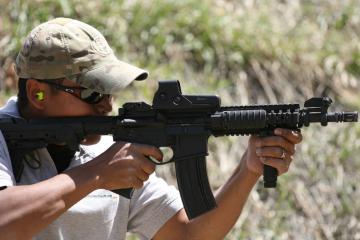Shotgun News 4 February 2008

 Optical sights have come of age on fighting rifles. Three examplary choices are the S&B Short Dot
(top), Aimpoint M3 (middle), and Trijicon TA11 ACOG (bottom). Photo credit Jeff Carpenter.
Now that optics have come of age on fighting rifles, one of the most compelling reasons to have a
longer barrel has been removed. With iron sights such as those on the M16A2, practical accuracy
depends on sight radius; it is easier to shoot accurately with more distance between the front and
rear sight. Optical sights have no sight radius; barrel or weapon length is now separated from the
ability to obtain a precise sight picture. This change allows a 14.5-inch M4 to have the same
sighting precision as a 20-inch M16A2 or even sniper rifle.

 Shown here at an EAG Tactical Carbine Operators class, Type I sights, red-dot optics with no
magnification, are most popular.
Short-barreled rifles are becoming standard on the battlefield. The Army is issuing the M4 on a
widespread basis because of extensive vehicle-mounted use. Even shorter carbines are seeing use,
such as the Mk18 Mod 0 CQBR with its 10.3-inch barrel. For close-quarters or low-profile protection
work, compact carbines with ten to 12-inch barrels are common. Short-barreled rifles are also a
good choice for suppressed use since a 20-inch M16 or even a 14.5-inch M4 will become a long package
when a suppressor is added.

 The EOTech holographic red dot optic can be a viable fighting optic, however, manipulating it
is more complicated than the Aimpoint.
Conventional wisdom is that a long barrel is required for accuracy. More velocity does reduce wind
drift and bullet drop at longer ranges, however, outside of Bench Rest games, a short barrel can be
just as mechanically accurate as a long barrel. Real-world accuracy of an AR-15 is determined by
barrel quality, ammunition choice, and upper assembly build quality.
The short yet accurate barrel has become popular recently due to demand for a compact carbine which
can deliver sub-MOA accuracy at extended ranges. Rules of engagement often dictate positive target
identification and shot placement. The "Recce" format originated in Naval Special Warfare (NSW) due
to the need to equip snipers with a combat precision weapon which could use common ammunition. The
Recce has a 16-inch stainless match barrel and free-floated railed hand-guard, and is fitted with a
low-power magnified optic. The concept has been shortened even further into sub-MOA short-barreled
rifles in the ten to 12-inch range. A skilled shooter can hold these short carbines to MOA at 600
yards or further.
With those facts set out, it becomes clear that carbine capability is primarily determined by the
sighting system. The same weapon could be optimized for door kicking, close to mid-range
engagements with target identification requirements, or can be stretched to the cartridge's
ballistic limit by merely changing the optic.

 The EOTech provides fast, heads-up sighting, and suits the short-barreled rifle well.
Practical competition is the petri dish in which superior gun-handling, marksmanship, and speed
skills are developed. The "modern" technique of pistol shooting developed in the 1970s by IPSC
shooters provides the basis of combat handgun training today. The rifle hasn't been left behind;
three-gun and practical rifle matches likewise have provided an important testing and proving forum
for equipment, technique, and skill advances. It's common for top practical shooters to instruct
our warriors, and it's common for tools and techniques developed in practical shooting games to
migrate to the tactical side, and vice versa. Outside of tactics, the shooting problem is much the
same: make hits as quickly as possible, under pressure and while moving.
It's no surprise, then, that common themes in sighting systems arise. I'm going to break these down
into three categories: Type I, Type II, and Type III.
|